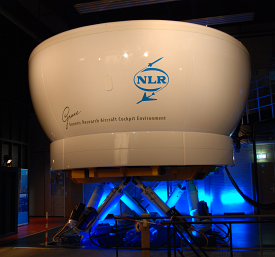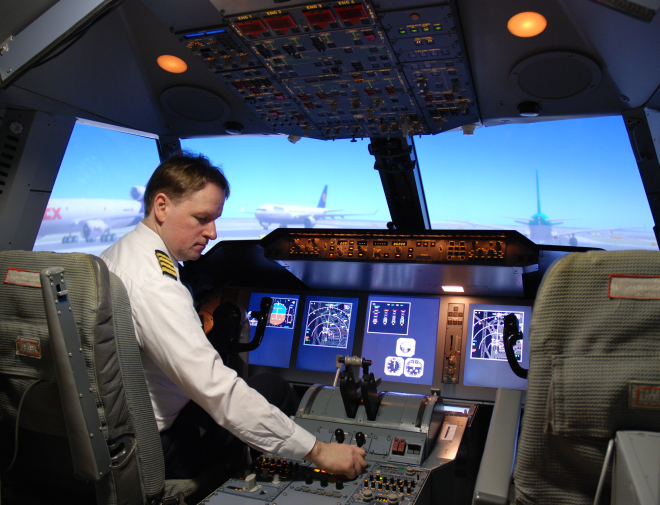
NLR’s Generic Research Aircraft Cockpit Environment (GRACE)
The National Aerospace Laboratory of the Netherlands (NLR) has installed a new projection system and supporting software to significantly enhance the level of realism offered by its Generic Research Aircraft Cockpit Environment (GRACE). The WIDE VISUAL upgrade allows for the testing of more complex manoeuvres, which ultimately will contribute to greater aviation safety. The installation phase has now been completed and test pilots have started working with the new capabilities.Simulation environments play a crucial role in training pilots and testing new procedures and technology. For this purpose NLR has set up the GRACE simulator at its Amsterdam location. GRACE consists of a realistic cockpit fitted with modular equipment. The cockpit can be moved around in space using an electrically powered platform. Although GRACE has proved its usefulness on many occasions, updated graphic software and hardware has now become available to further close the gap between simulation and actual flight.The WIDE VISUAL projection system consists of three projectors, a massive mirror, and a convex projection screen that offers pilots a virtually complete field of vision. The previous system had a narrower field of vision, and did not allow pilots and co-pilots to look over each other’s shoulder. The LED lamps in the new projectors are more energy-efficient than the traditional projector lamps.
The improved view from the cockpit simulator is more important than may initially appear. During taxiing, for instance, it is customary for pilots to look over each other’s shoulder to check for other taxiing aircraft or obstacles. If an airport is situated in a mountainous area or otherwise difficult to approach, smaller aircraft usually fly over the runway to establish its precise location before the actual landing. Training such manoeuvres is now possible thanks to the WIDE VISUAL upgrade.
WIDE VISUAL is already extensively used in the ARISTOTEL project (‘Aircraft and Rotorcraft Pilot Coupling , Tools and Techniques for Alleviation and Detection’). This project is aimed at preventing ‘aircraft-pilot coupling’, a phenomenon in which the pilot interacts incorrectly with the control system. The aircraft can become difficult to manage, with all the risks this entails.
In one of the experiments conducted as part of this project, a pilot was asked to respond adequately to a scenario in which the runway suddenly moves 30 metres sideways. The corrective control inputs by the pilot provide insight into the mechanisms underlying aircraft-pilot coupling.
The scenario examined a range of variables, including the settings of the control system and the elasticity of the aircraft body and wings. The results will be used to draw up recommendations for design changes to control systems that are still in the development stage and future control systems. This demonstrates how the WIDE VISUAL can be used to support the aviation industry in making air travel even safer for all concerned.

The new GRACE wide visual


